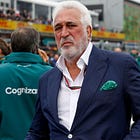When Ads Disappear
What WhatsApp’s new Formula 1 doc on Netflix teaches us about the future of brand storytelling.
Welcome to Business of Speed.
In case you missed it:
If someone forwarded you this email, consider supporting independent coverage and analysis of the business of Formula 1.
Imagine for a moment:
You’re sitting in a boardroom. The Chief Marketing Officer stands in front of a whiteboard labeled Brand Objectives.
Someone says the word “synergy.”
Heads nod in agreement.
There's a slide showing WhatsApp’s security features. A montage of engineers sending emoji-filled group messages ends with a voiceover: “WhatsApp: connecting champions.”
😬
Thank goodness for the folks at WhatsApp, Modern Arts, and Mercedes AMG Petronas; we don’t have that.
Instead of a boring sponsor advert featuring a driver, we get a cinematic, emotionally intelligent piece of beautiful content that features a brand. That’s the holy trinity.
Modern Arts CEO Brooke Stites said it best:
“You have to have an amazing story and quality of craft. Streamers aren’t asking if it promotes your brand—they’re asking if it adds value to their audience”
That’s the bar now. And it should terrify bad marketers.
Advertising sucks.
We’ve been conditioned to expect brand campaigns to be flashy, formulaic, and a little desperate. They scream for our attention, then vanish the moment we scroll past. But every once in a while, a brand pulls off something so deft, so culturally native, it doesn’t feel like advertising at all. It feels like entertainment.
That’s precisely what WhatsApp has done with The Seat, a new Netflix documentary that chronicles how Mercedes-AMG F1 chose Lewis Hamilton’s successor.
Yes, it’s a commercial. But you’d probably never even realize it.
And that’s the point.
This isn’t just clever marketing. It creates the future blueprint for sponsor and brand communication.
But you have to allow your product to disappear entirely into the story so that it becomes part of the culture, not a footnote to it.
Let’s break it down.
Most Ads
Most ads are built around two questions:
How do we show the product?
How often can we show the product?
But The Seat flips those entirely:
What story is already unfolding in the world?
How does our product naturally belong in it?
The distinction is massive. The former creates interruption. The latter creates resonance.
Here’s what WhatsApp and their agency, Modern Arts, understood that many marketers don’t:
Your product is not the story—it’s the stage. Let the drama unfold without putting a logo in the spotlight.
Culture is the context. If you’re not adding to it, you’re borrowing against it.
Distribution matters. Netflix didn’t take this because it was branded content. They took it because it was good content.
If you're a brand marketer, founder, current sponsor, or content creator trying to “break into culture,” stop looking for ways to insert your brand into existing narratives. Instead, start asking: What stories are already happening where our product is essential but invisible?
Then, tell that story better than anyone else.
The world is drowning in content.
The smartest way to stand out…is to vanish into the plot.






